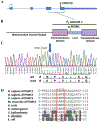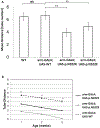A Novel Variant of ATP5MC3 Associated with Both Dystonia and Spastic Paraplegia
- PMID: 34636445
- PMCID: PMC8840961
- DOI: 10.1002/mds.28821
A Novel Variant of ATP5MC3 Associated with Both Dystonia and Spastic Paraplegia
Abstract
Background: In a large pedigree with an unusual phenotype of spastic paraplegia or dystonia and autosomal dominant inheritance, linkage analysis previously mapped the disease to chromosome 2q24-2q31.
Objective: The aim of this study is to identify the genetic cause and molecular basis of an unusual autosomal dominant spastic paraplegia and dystonia.
Methods: Whole exome sequencing following linkage analysis was used to identify the genetic cause in a large family. Cosegregation analysis was also performed. An additional 384 individuals with spastic paraplegia or dystonia were screened for pathogenic sequence variants in the adenosine triphosphate (ATP) synthase membrane subunit C locus 3 gene (ATP5MC3). The identified variant was submitted to the "GeneMatcher" program for recruitment of additional subjects. Mitochondrial functions were analyzed in patient-derived fibroblast cell lines. Transgenic Drosophila carrying mutants were studied for movement behavior and mitochondrial function.
Results: Exome analysis revealed a variant (c.318C > G; p.Asn106Lys) (NM_001689.4) in ATP5MC3 in a large family with autosomal dominant spastic paraplegia and dystonia that cosegregated with affected individuals. No variants were identified in an additional 384 individuals with spastic paraplegia or dystonia. GeneMatcher identified an individual with the same genetic change, acquired de novo, who manifested upper-limb dystonia. Patient fibroblast studies showed impaired complex V activity, ATP generation, and oxygen consumption. Drosophila carrying orthologous mutations also exhibited impaired mitochondrial function and displayed reduced mobility.
Conclusion: A unique form of familial spastic paraplegia and dystonia is associated with a heterozygous ATP5MC3 variant that also reduces mitochondrial complex V activity.
© 2021 International Parkinson and Movement Disorder Society.
Figures




Similar articles
-
Autosomal dominant GCH1 mutations causing spastic paraplegia at disease onset.Parkinsonism Relat Disord. 2020 May;74:12-15. doi: 10.1016/j.parkreldis.2020.03.019. Epub 2020 Apr 1. Parkinsonism Relat Disord. 2020. PMID: 32278297
-
Recessive null-allele variants in MAG associated with spastic ataxia, nystagmus, neuropathy, and dystonia.Parkinsonism Relat Disord. 2020 Aug;77:70-75. doi: 10.1016/j.parkreldis.2020.06.027. Epub 2020 Jun 29. Parkinsonism Relat Disord. 2020. PMID: 32629324
-
De Novo and Dominantly Inherited SPTAN1 Mutations Cause Spastic Paraplegia and Cerebellar Ataxia.Mov Disord. 2022 Jun;37(6):1175-1186. doi: 10.1002/mds.28959. Epub 2022 Feb 12. Mov Disord. 2022. PMID: 35150594 Free PMC article.
-
More autosomal dominant SPG18 cases than recessive? The first AD-SPG18 pedigree in Chinese and literature review.Brain Behav. 2021 Dec;11(12):e32395. doi: 10.1002/brb3.2395. Epub 2021 Nov 3. Brain Behav. 2021. PMID: 34734492 Free PMC article. Review.
-
Spastic paraplegia type 46: novel and recurrent GBA2 gene variants in a compound heterozygous Italian patient with spastic ataxia phenotype.Neurol Sci. 2021 Nov;42(11):4741-4745. doi: 10.1007/s10072-021-05463-0. Epub 2021 Jul 12. Neurol Sci. 2021. PMID: 34251556 Review.
Cited by
-
Impacts of mitochondrial dysfunction on axonal microtubule bundles as a potential mechanism of neurodegeneration.Front Neurosci. 2025 Aug 19;19:1631752. doi: 10.3389/fnins.2025.1631752. eCollection 2025. Front Neurosci. 2025. PMID: 40904733 Free PMC article. Review.
-
Mutation screening of AOPEP variants in a large dystonia cohort.J Neurol. 2023 Jun;270(6):3225-3233. doi: 10.1007/s00415-023-11665-7. Epub 2023 Mar 18. J Neurol. 2023. PMID: 36933031
-
Identifying links between cardiovascular disease and insomnia by modeling genes from a pleiotropic locus.Dis Model Mech. 2025 May 1;18(5):dmm052139. doi: 10.1242/dmm.052139. Epub 2025 May 6. Dis Model Mech. 2025. PMID: 40176577 Free PMC article.
-
Integration of Human Protein Sequence and Protein-Protein Interaction Data by Graph Autoencoder to Identify Novel Protein-Abnormal Phenotype Associations.Cells. 2022 Aug 10;11(16):2485. doi: 10.3390/cells11162485. Cells. 2022. PMID: 36010562 Free PMC article.
-
Variants in ATP5F1B are associated with dominantly inherited dystonia.Brain. 2023 Jul 3;146(7):2730-2738. doi: 10.1093/brain/awad068. Brain. 2023. PMID: 36860166 Free PMC article.
References
-
- Draganski B, Bhatia KP. Brain structure in movement disorders: a neuroimaging perspective. Current Opinion in Neurology 2010;23(4):413–419. - PubMed
-
- Parodi L, Fenu S, Stevanin G, Durr A. Hereditary spastic paraplegia: More than an upper motor neuron disease. Rev Neurol (Paris) 2017;173(5):352–360. - PubMed
-
- Klebe S, Stevanin G, Depienne C. Clinical and genetic heterogeneity in hereditary spastic paraplegias: from SPG1 to SPG72 and still counting. Rev Neurol (Paris) 2015;171(6–7):505–530. - PubMed
Publication types
MeSH terms
Grants and funding
LinkOut - more resources
Full Text Sources
Medical
Molecular Biology Databases

